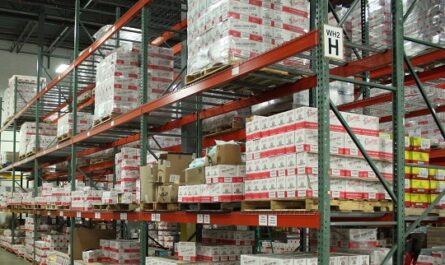Supply chains are complex systems that involve numerous interconnected processes, stakeholders, and potential areas for improvement. With so many challenges and opportunities, it is easy for you to become overwhelmed and lose focus.
However, identifying the specific areas of the supply chain that require attention and prioritization is crucial for achieving operational excellence and maximizing efficiency.
In this blog post, we will explore the best practices and key clues to help you identify which part of the supply chain to focus on.
But before we delve deeper, make sure you have joined the scmguide telegram channel to receive notifications of the latest posts from this blog as well as more insights on supply chain management.
Table of Contents
Analyzing Performance Metrics
When it comes to identifying areas of improvement in your supply chain, one of the best approaches is to analyze key performance metrics.
By examining metrics such as delivery time, order accuracy, inventory turnover, and customer satisfaction, you can gain valuable insights into the areas that may be underperforming.
This analysis allows you to focus on specific aspects of your supply chain that require attention and improvement.
For instance, let’s say you notice that your delivery time consistently exceeds industry standards. This finding suggests a potential bottleneck in your logistics or distribution processes.
By recognizing this gap through performance metrics, you can prioritize efforts to improve the corresponding areas of your supply chain.
Moreover, by scrutinizing other metrics like order accuracy, you can identify potential issues within your operations.
If you observe a high rate of incorrect orders or discrepancies between orders placed and delivered, it may indicate problems in inventory management or order fulfillment processes. Identifying these performance gaps empowers you to address them promptly and enhance the overall efficiency of your supply chain.
Another crucial metric to consider is inventory turnover, which measures how quickly your inventory is sold and replaced.

If you notice a low turnover rate or excessive stock levels, it could signify problems in demand forecasting, production planning, or inventory control.
By analyzing this metric, you can pinpoint areas that need improvement and optimize your inventory management practices accordingly.
Additionally, examining customer satisfaction metrics provides valuable insights into the performance of your supply chain from the customer’s perspective.
Monitoring customer feedback, reviews, and ratings helps you understand their experiences and expectations. If you consistently receive complaints about delayed deliveries or damaged products, it indicates areas within your supply chain that require attention, such as transportation or packaging processes.
Addressing these issues based on customer feedback allows you to align your supply chain with customer expectations and enhance their satisfaction.
You might also like:
- Staying Ahead in the Fast-Paced FMCG Market: The Key Lies in Responsiveness
- No One-Size-Fits-All Solution in Supply Chain: Why Every Company is Unique
Conducting Root Cause Analysis
Another effective method for you to identify which part of the supply chain needs attention is through conducting a root cause analysis. This process involves delving deep into the underlying causes of issues or inefficiencies within your supply chain.
By utilizing techniques such as the 5 Whys or fishbone diagrams, you can systematically trace problems back to their root causes and address them effectively.
For example, let’s say you frequently experience stockouts in your inventory. Instead of solely addressing the immediate issue of stockouts, conducting a root cause analysis allows you to investigate the factors that contribute to this problem.
By asking “why” multiple times, you can uncover the underlying causes. It could reveal that inaccurate demand forecasting is leading to insufficient stock levels, or poor supplier management is resulting in delayed or inadequate deliveries.
By identifying and addressing these root causes, you can improve the overall performance of your supply chain and mitigate the occurrence of stockouts.

Similarly, the fishbone diagram, also known as the Ishikawa diagram, is a visual tool that helps you identify the potential causes of a problem. The diagram categorizes possible causes into different branches, such as people, process, equipment, materials, and environment.
By analyzing each branch, you can identify specific areas that contribute to the issue at hand. This method can be particularly useful when trying to understand complex supply chain problems that have multiple interrelated factors.
Conducting a root cause analysis not only helps you identify the areas of the supply chain that require attention but also allows you to develop targeted and effective solutions.
By addressing the underlying causes rather than just the symptoms, you can make sustainable improvements and prevent issues from recurring.
It’s important to note that conducting a root cause analysis requires a systematic and collaborative approach. Involving cross-functional teams and stakeholders can provide diverse perspectives and insights, leading to a more comprehensive analysis.
By encouraging open communication and collaboration, you can uncover hidden issues and find innovative solutions that address the root causes of problems.
You might also like:
- Prioritizing Your Efforts: Don’t Get Overwhelmed with Supply Chain Management
- Mastering the Game of Supply Chain Management: Think Like a Chess Player
Seeking Customer Feedback
You play a crucial role in identifying areas of the supply chain that require improvement.
As customers, you directly experience the outcomes of supply chain processes and can provide valuable feedback. Your insights are essential in helping businesses understand where improvements are needed.
Conducting surveys, analyzing customer complaints, and monitoring social media platforms are effective ways for businesses to gather your feedback.
When you provide feedback through surveys, it allows businesses to gather quantitative data and measure your satisfaction levels.
By asking specific questions related to the supply chain, such as delivery times, product quality, or packaging, companies can gain insights into areas that may need improvement.

Your responses provide valuable information for businesses to evaluate their supply chain performance and identify potential pain points.
Customer complaints are another valuable source of feedback.
When you voice your concerns about delayed deliveries or damaged products, it highlights specific areas in the supply chain that need attention.
For instance, recurring complaints about late deliveries may indicate issues with transportation logistics or inefficient inventory management. By actively addressing these complaints and finding solutions, businesses can improve their supply chain operations and better meet your expectations.
In today’s digital age, social media platforms serve as a powerful tool for you to share your experiences and opinions. Monitoring social media channels allows businesses to gather real-time feedback and identify areas of improvement.
By paying attention to posts, comments, and reviews, companies can gain insights into your perceptions of their supply chain performance.
For example, if multiple customers express dissatisfaction with the packaging of products, it signals the need for businesses to focus on improving their packaging processes.
Incorporating customer feedback into improvement initiatives is crucial for businesses to align their supply chain with your expectations.
By actively listening to your suggestions and concerns, companies can identify areas that require attention and prioritize improvement efforts accordingly.
When businesses value your feedback and take action based on your input, it demonstrates a customer-centric approach and strengthens their relationship with you.
You might also like:
- Too Much Collaboration in Supply Chain Management? Understanding the Risks
- Don’t Ignore the Risks: The Case for Supply Chain Risk Management
Embracing Technology and Innovation
You have the opportunity to drive supply chain optimization by embracing technology and innovation.
By leveraging advanced analytics, automation, and data management systems, you can gain valuable insights into your supply chain operations and make informed decisions.
One way to harness technology is through the implementation of advanced analytics tools.

By analyzing large volumes of data generated throughout the supply chain, you can uncover patterns, trends, and potential areas for improvement.
For instance, predictive analytics can help you forecast demand more accurately, enabling better inventory management and reducing stockouts or overstocks. By using analytics, you can optimize your supply chain processes and enhance overall efficiency.
Automation is another technology that can significantly improve your supply chain. By automating repetitive and time-consuming tasks, such as order processing, inventory tracking, or invoicing, you can reduce human error, increase speed, and free up resources for more strategic activities.
Robotic process automation (RPA), for example, can streamline order fulfillment processes by automatically generating and sending invoices, tracking shipments, and updating inventory records.
By embracing automation, you can enhance efficiency and focus on value-added activities.
Data management systems are essential for organizing and accessing supply chain data effectively. By implementing robust systems that centralize and integrate data from various sources, you can gain a holistic view of your supply chain.
This enables you to identify bottlenecks, analyze performance, and make data-driven decisions. With the availability of real-time data, you can proactively address issues, optimize inventory levels, and improve overall responsiveness.
Emerging technologies such as blockchain and the Internet of Things (IoT) offer immense potential for transforming supply chain operations. Blockchain can enhance traceability and transparency by providing an immutable record of transactions and product movements.
This technology enables you to verify the authenticity and origin of products, track inventory, and improve supply chain visibility. IoT devices, on the other hand, can collect real-time data from various points in the supply chain, allowing you to monitor conditions, optimize routes, and identify potential risks.
By embracing these technologies, you can enhance operational efficiency, reduce costs, and ensure greater trust and transparency throughout your supply chain.

Incorporating technology and innovation into your supply chain operations empowers you to identify areas for improvement and streamline processes effectively.
By leveraging advanced analytics, automation, data management systems, and emerging technologies, you can make data-driven decisions, optimize operations, and drive continuous improvement.
Embracing technology not only improves your supply chain performance but also positions you at the forefront of industry trends and enables you to stay competitive in an ever-evolving business landscape.
Conclusion
In conclusion, as you strive to optimize your supply chain and achieve operational excellence, it is crucial to identify the areas that require your focus and prioritization.
By actively engaging in the processes of analyzing performance metrics, conducting root cause analysis, seeking customer feedback, and embracing technology and innovation, you can gain valuable insights into the strengths and weaknesses of your supply chain.
Analyzing performance metrics allows you to assess the effectiveness of various aspects of your supply chain, such as delivery time, order accuracy, inventory turnover, and customer satisfaction.
By closely monitoring these metrics, you can identify areas that may be underperforming and prioritize improvement efforts accordingly.
Conducting root cause analysis enables you to investigate the underlying causes of issues or inefficiencies within your supply chain.
By utilizing techniques like the 5 Whys or fishbone diagrams, you can trace problems back to their root causes and address them effectively. This approach helps you address the fundamental issues rather than just treating the symptoms, leading to sustainable improvements.
Seeking customer feedback is invaluable in understanding their experiences and expectations. By actively listening to their opinions, analyzing complaints, and monitoring social media platforms, you can gain insights into areas that require improvement.
Incorporating customer feedback into your improvement initiatives helps align your supply chain with customer expectations and enhances overall customer satisfaction.
Embracing technology and innovation is essential in today’s rapidly evolving business landscape. By leveraging advanced analytics, automation, data management systems, and emerging technologies like blockchain and IoT, you can gain a competitive edge.
These tools enable you to make data-driven decisions, streamline processes, and enhance supply chain visibility and transparency.
It’s important to remember that supply chains are dynamic and constantly evolving. Regular evaluation and adjustment of your focus areas are necessary to stay ahead of the competition and deliver enhanced value to your customers.
By adopting a proactive approach and continuously monitoring the performance of your supply chain, you can identify emerging trends, address challenges, and seize opportunities for improvement.
Hope it is useful!
Please also share this article with your colleagues so that they can benefit from it as well. Join our scmguide telegram channel to receive notifications of the latest posts from this blog and gain more insights into supply chain management. All articles on this blog are free for you to use for any purpose, including commercial, without the need for attribution.

 by
by 

